ECU Citroen DS5 HYBRID4 2015.5 1.G User Guide
[x] Cancel search | Manufacturer: CITROEN, Model Year: 2015.5, Model line: DS5 HYBRID4, Model: Citroen DS5 HYBRID4 2015.5 1.GPages: 400, PDF Size: 23.96 MB
Page 190 of 400
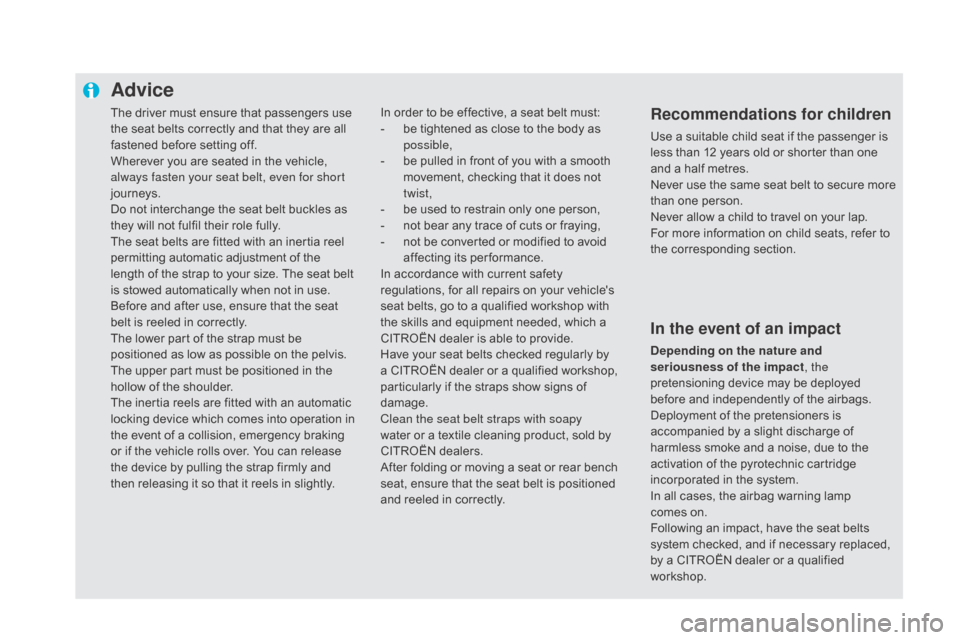
The driver must ensure that passengers use
the seat belts correctly and that they are all
fastened before setting off.
Wherever you are seated in the vehicle,
always fasten your seat belt, even for short
journeys.
Do not interchange the seat belt buckles as
they will not fulfil their role fully.
The seat belts are fitted with an inertia reel
permitting automatic adjustment of the
length of the strap to your size. The seat belt
is stowed automatically when not in use.
Before and after use, ensure that the seat
belt is reeled in correctly.
The lower part of the strap must be
positioned as low as possible on the pelvis.
The upper part must be positioned in the
hollow of the shoulder.
The inertia reels are fitted with an automatic
locking device which comes into operation in
the event of a collision, emergency braking
or if the vehicle rolls over. You can release
the device by pulling the strap firmly and
then releasing it so that it reels in slightly.Recommendations for children
Use a suitable child seat if the passenger is
less than 12 years old or shorter than one
and a half metres.
Never use the same seat belt to secure more
than one person.
Never allow a child to travel on your lap.
For more information on child seats, refer to
the corresponding section.
In order to be effective, a seat belt must:
-
b
e tightened as close to the body as
possible,
-
b
e pulled in front of you with a smooth
movement, checking that it does not
twist,
-
b
e used to restrain only one person,
-
n
ot bear any trace of cuts or fraying,
-
n
ot be converted or modified to avoid
affecting its performance.
In accordance with current safety
regulations, for all repairs on your vehicle's
seat belts, go to a qualified workshop with
the skills and equipment needed, which a
CITROËN dealer is able to provide.
Have your seat belts checked regularly by
a CITROËN dealer or a qualified workshop,
particularly if the straps show signs of
damage.
Clean the seat belt straps with soapy
water or a textile cleaning product, sold by
CITROËN dealers.
After folding or moving a seat or rear bench
seat, ensure that the seat belt is positioned
and reeled in correctly.
In the event of an impact
depending on the nature and
seriousness of the impact , the
pretensioning device may be deployed
before and independently of the airbags.
Deployment of the pretensioners is
accompanied by a slight discharge of
harmless smoke and a noise, due to the
activation of the pyrotechnic cartridge
incorporated in the system.
In all cases, the airbag warning lamp
comes on.
Following an impact, have the seat belts
system checked, and if necessary replaced,
by a CITROËN dealer or a qualified
workshop.
Advice
Page 194 of 400
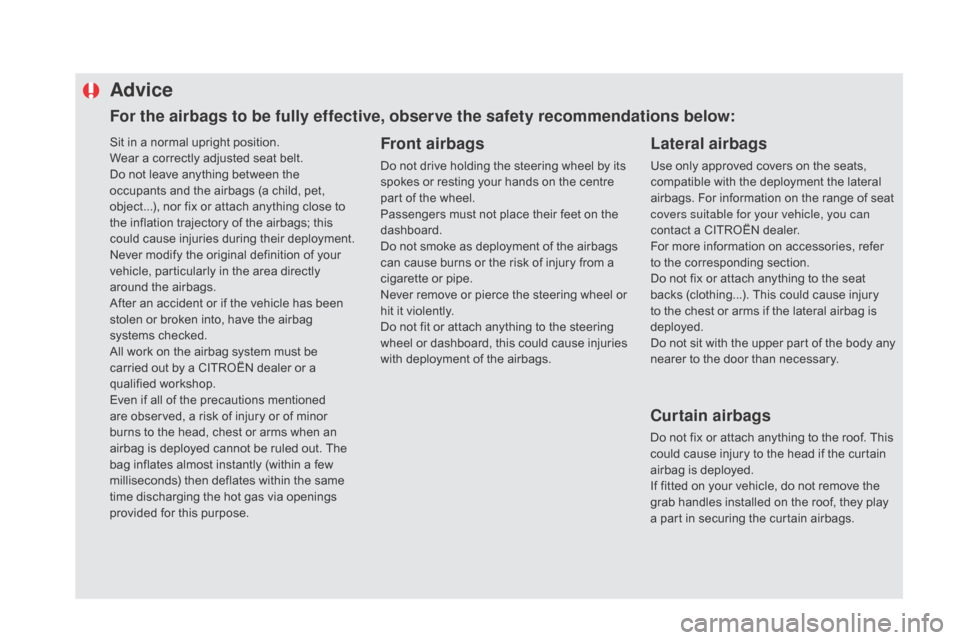
Sit in a normal upright position.
Wear a correctly adjusted seat belt.
Do not leave anything between the
occupants and the airbags (a child, pet,
object...), nor fix or attach anything close to
the inflation trajectory of the airbags; this
could cause injuries during their deployment.
Never modify the original definition of your
vehicle, particularly in the area directly
around the airbags.
After an accident or if the vehicle has been
stolen or broken into, have the airbag
systems checked.
All work on the airbag system must be
carried out by a CITROËN dealer or a
qualified workshop.
Even if all of the precautions mentioned
are observed, a risk of injury or of minor
burns to the head, chest or arms when an
airbag is deployed cannot be ruled out. The
bag inflates almost instantly (within a few
milliseconds) then deflates within the same
time discharging the hot gas via openings
provided for this purpose.Lateral airbags
Use only approved covers on the seats,
compatible with the deployment the lateral
airbags. For information on the range of seat
covers suitable for your vehicle, you can
contact a CITROËN dealer.
For more information on accessories, refer
to the corresponding section.
Do not fix or attach anything to the seat
backs (clothing...). This could cause injury
to the chest or arms if the lateral airbag is
deployed.
Do not sit with the upper part of the body any
nearer to the door than necessary.
Front airbags
Do not drive holding the steering wheel by its
spokes or resting your hands on the centre
part of the wheel.
Passengers must not place their feet on the
dashboard.
Do not smoke as deployment of the airbags
can cause burns or the risk of injury from a
cigarette or pipe.
Never remove or pierce the steering wheel or
hit it violently.
Do not fit or attach anything to the steering
wheel or dashboard, this could cause injuries
with deployment of the airbags.
Advice
curtain airbags
Do not fix or attach anything to the roof. This
could cause injury to the head if the curtain
airbag is deployed.
If fitted on your vehicle, do not remove the
grab handles installed on the roof, they play
a part in securing the curtain airbags.
For the airbags to be fully effective, observe the safety recommendations below:
Page 204 of 400

Changing a wheel
The jack is stowed in a box attached to the
spare wheel.
The assembly is secured under the vehicle by
means of a winch system.
Refer to the "Access to the spare wheel"
section.
To open the tool box:
F
p
ress the tab, slide the lid on the box half
way, then remove it.
Access to the tools
Procedure for changing a wheel with a damaged or punctured tyre for the spare wheel using the tools provided with the vehicle.
The other tools are stowed in a well under the
boot floor. The jack must only be used to change
a wheel with a damaged or punctured
tyre.
Do not use any jack other than the one
supplied with this vehicle.
If the vehicle does not have its original
jack, contact a CITROËN dealer or a
qualified workshop to obtain the correct
jack for it.
The jack does not require any
maintenance.
Page 205 of 400
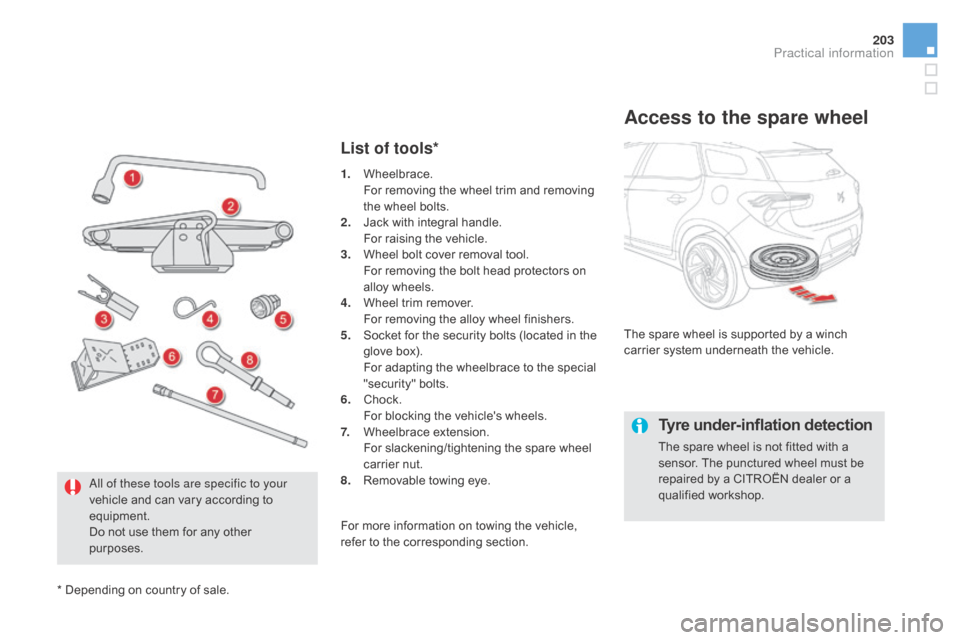
203
List of tools*
Access to the spare wheel
The spare wheel is supported by a winch
carrier system underneath the vehicle.
Tyre under-inflation detection
The spare wheel is not fitted with a
sensor. The punctured wheel must be
repaired by a CITROËN dealer or a
qualified workshop.
1.
W
heelbrace.
F
or removing the wheel trim and removing
the wheel bolts.
2.
J
ack with integral handle.
F
or raising the vehicle.
3.
W
heel bolt cover removal tool.
F
or removing the bolt head protectors on
alloy wheels.
4.
W
heel trim remover.
F
or removing the alloy wheel finishers.
5.
S
ocket for the security bolts (located in the
glove box).
F
or adapting the wheelbrace to the special
"security" bolts.
6.
Ch
ock.
F
or blocking the vehicle's wheels.
7. W
heelbrace extension. F
or slackening/tightening the spare wheel
carrier nut.
8.
R
emovable towing eye.
* Depending on country of sale. For more information on towing the vehicle,
refer to the corresponding section.
All of these tools are specific to your
vehicle and can vary according to
equipment.
Do not use them for any other
purposes.
Practical information
Page 207 of 400
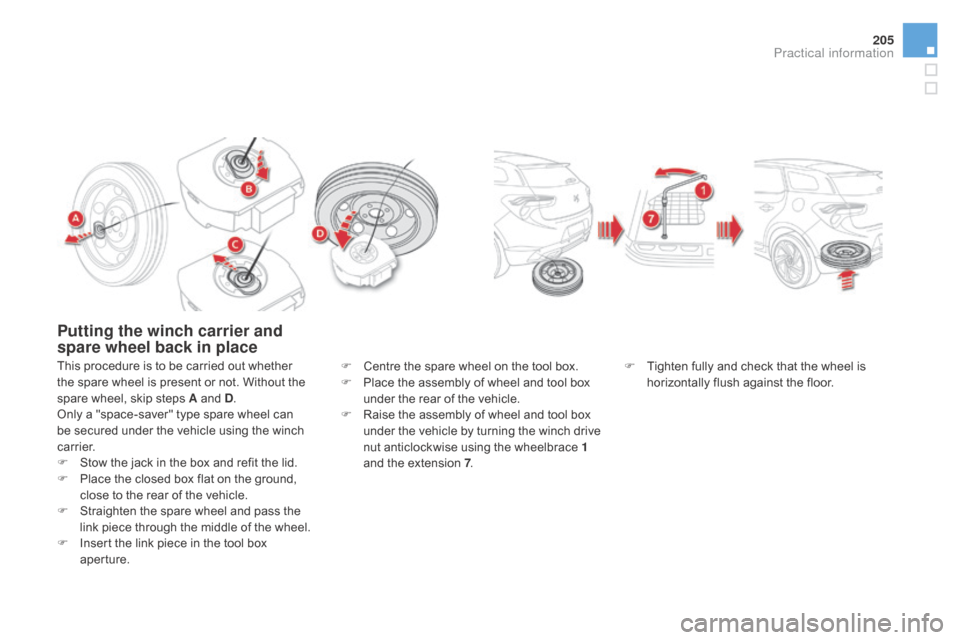
205
Putting the winch carrier and
spare wheel back in place
This procedure is to be carried out whether
the spare wheel is present or not. Without the
spare wheel, skip steps A and d
.
O
nly a "space-saver" type spare wheel can
be secured under the vehicle using the winch
c a r r i e r.
F
S
tow the jack in the box and refit the lid.
F
P
lace the closed box flat on the ground,
close to the rear of the vehicle.
F
S
traighten the spare wheel and pass the
link piece through the middle of the wheel.
F
I
nsert the link piece in the tool box
aperture. F
C entre the spare wheel on the tool box.
F
P
lace the assembly of wheel and tool box
under the rear of the vehicle.
F
R
aise the assembly of wheel and tool box
under the vehicle by turning the winch drive
nut anticlockwise using the wheelbrace 1
and the extension 7 . F
T ighten fully and check that the wheel is
horizontally flush against the floor.
Practical information
Page 208 of 400
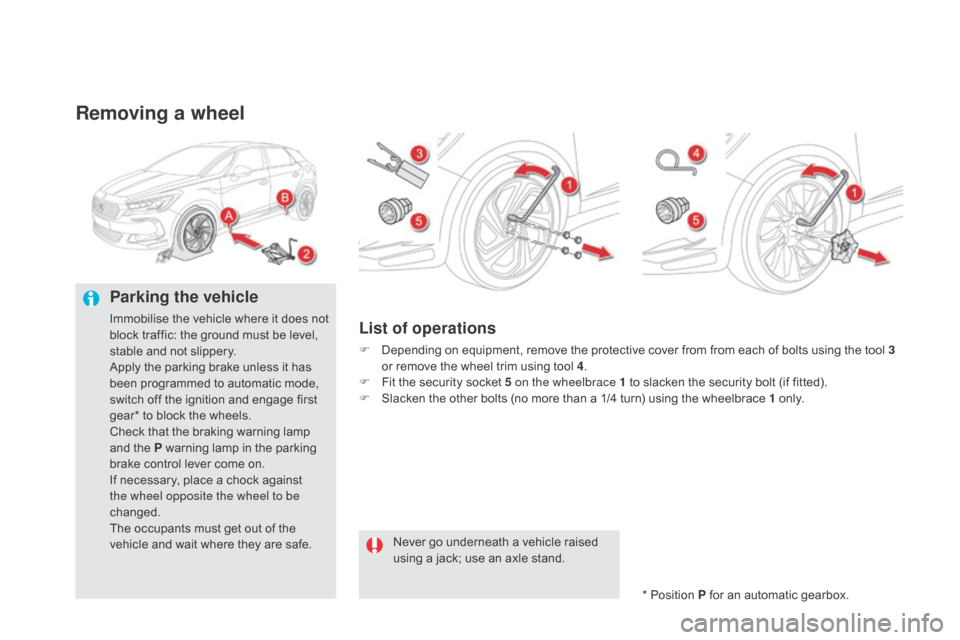
Removing a wheel
Parking the vehicle
Immobilise the vehicle where it does not
block traffic: the ground must be level,
stable and not slippery.
Apply the parking brake unless it has
been programmed to automatic mode,
switch off the ignition and engage first
gear* to block the wheels.
Check that the braking warning lamp
and the P warning lamp in the parking
brake control lever come on.
If necessary, place a chock against
the wheel opposite the wheel to be
changed.
The occupants must get out of the
vehicle and wait where they are safe.List of operations
F Depending on equipment, remove the protective cover from from each of bolts using the tool 3 or remove the wheel trim using tool 4 .
F
F
it the security socket 5 on the wheelbrace 1 to slacken the security bolt (if fitted).
F
S
lacken the other bolts (no more than a 1/4 turn) using the wheelbrace 1 o n l y.
* Position P for an automatic gearbox.
Never go underneath a vehicle raised
using a jack; use an axle stand.
Page 210 of 400

Fitting a wheel
Fitting the "space-saver"
spare wheel
If your vehicle is fitted with alloy wheels,
when tightening the bolts on fitting, it
is normal to notice that the washers
do not come into contact with the
"space-saver" spare wheel. The wheel
is secured by the conical sur face of
each bolt.
After changing a wheel
The wheel with the punctured tyre
cannot be fitted under the vehicle. It
must be stowed flat on the boot floor;
use a cover to protect the inside of the
boot.
Do not exceed 50 mph (80 km/h) when
driving with the "space-saver" type
spare wheel fitted.
Have the tightening of the bolts and the
pressure of the spare wheel checked
by a CITROËN dealer or a qualified
workshop without delay.
Have the punctured wheel repaired
and refitted to the vehicle as soon as
possible.
List of operations
F Put the wheel in place on the hub.
F S crew in the bolts fully by hand.
F
P
re-tighten the security bolt using the
wheelbrace 1 fitted with the security
socket 5.
F
P
re-tighten the other bolts using the
wheelbrace 1 o n l y.
Page 211 of 400
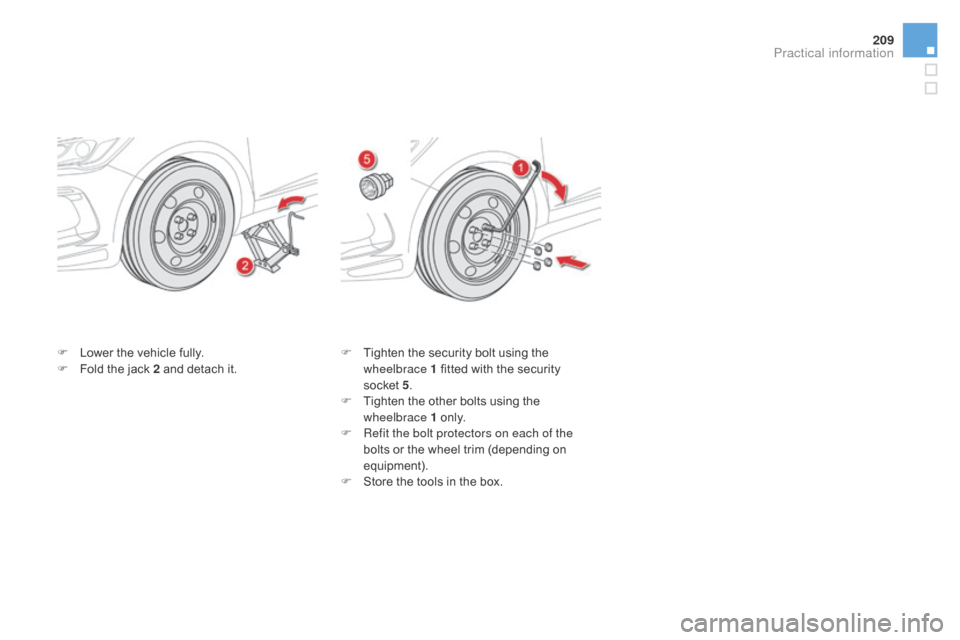
209
F Lower the vehicle fully.
F F old the jack 2 and detach it. F
T ighten the security bolt using the
wheelbrace 1 fitted with the security
socket 5.
F
T
ighten the other bolts using the
wheelbrace 1 o n l y.
F
R
efit the bolt protectors on each of the
bolts or the wheel trim (depending on
equipment).
F
S
tore the tools in the box.
Practical information
Page 221 of 400

219
Changing a fuse
The fuse extraction tweezer is fitted to the back
of the dashboard fusebox cover.
For access to it:
F
r
emove the cover completely and turn it
ove r,
F
r
emove the tweezer.
Access to tooling
Before changing a fuse, it is necessary to:
F i dentify the cause of the failure and
correct it,
F
s
witch off all electrical consumers,
F
i
mmobilise the vehicle and switch off the
ignition,
F
i
dentify the failed fuse using the allocation
tables and diagrams presented on the
following pages.
changing a fuse
good Failed
To remove or fit a fuse, it is essential to:
F
u
se the special tweezer to extract the fuse
from its housing and check the condition of
its filament.
F
a
lways replace the failed fuse with a fuse
of the same rating (same colour); a fuse of
different rating could cause a fault (risk of
f i r e).
The replacement of a fuse not
mentioned in the tables below could
cause a serious malfunction of your
vehicle. Contact a CITROËN dealer or a
qualified workshop.
If the fault recurs after replacing a fuse, have
the electrical system checked by a CITROËN
dealer or a qualified workshop. Tw e e z e r
Practical information
Page 232 of 400

Towing your vehicleTowing another vehicle
F On the front bumper, unclip the cover
by pressing at the top to disengage the
securing lugs.
F
S
crew the towing eye in fully.
F
I
nstall the towing arm. F
O n the rear bumper, unclip the cover by
levering at the left with the point of the
towing eye.
F
S
crew the towing eye in fully.
F
I
nstall the towing arm.
F
S
witch on the hazard warning lamps on
both vehicles.
F
M
ove off gently and drive at low speed and
for a short distance only.
F
P
lace the gear lever in neutral
(position
n
with an automatic
gearbox).
F
ailure to follow this advice could
result in damage to certain systems
(braking, transmission...) and the
absence of braking assistance the
next time the engine is started.
F U nlock the steering and release the
parking brake.
F
S
witch on the hazard warning lamps on
both vehicles.
F
M
ove off gently and drive at low speed and
for a short distance only.